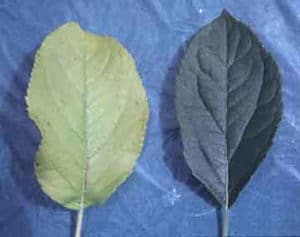Recognize the visual signs of micronutrient deficiencies in apples
Macronutrients tend to get all of the attention when it comes to plant nutrition, while micronutrients are frequently overlooked. When left untreated, micronutrient deficiencies and toxicities can severely affect plant health. Plants send out warning signals in the form of visual symptoms when they are under stress. These stresses might be nutrient related or they might be the result of other factors. In order to effectively treat a problem, growers must be able to pinpoint its exact cause. Being able to recognize the visual symptoms of micronutrient deficiencies can help when trying to make an accurate diagnosis.
Some common visual symptoms of micronutrient deficiencies in apples include:
Symptoms of boron (B) deficiencies show up on the fruit, shoots, and leaves of trees. Corking, internally or externally, is a common problem with apple fruit, along with bumpiness and cracking. Dieback occurs in shoots and tips. Leaves begin to turn yellow and their veins redden, distortions frequently occur. Leaf and flower buds may fail to break dormancy.
Iron (Fe) deficiencies can be the result of overwatering, high soil pH, poor soil aeration, and alkaline soils. The leaves of Fe deficient plants become chlorotic and have light green veins. Leaf tips and margins become necrotic as the severity of the problem increases. Shoot growth is stunted and there is a noticeable decrease in flower and fruiting.
Manganese (Mn) deficiencies first appear on the middle-aged and older leaves of apple trees. Interveinal chlorosis is present and the leaves drop prematurely. Shoots are weak and thin; dieback occurs in acute cases. ‘Golden Delicious’ apples can develop “bark measles” when Mn is excessive.
Low levels of zinc (Zn) can cause apples to ripen early and lack flavor. Leaves on terminal shoots become mottled, and chlorosis may be present between the veins. Rosettes can form on distorted shoot tips. Excessive amounts of Zn can lead to Cu deficiencies.
High concentrations of phosphorus (P) in apple trees and their surrounding soils contribute to copper (Cu) deficiencies. New leaves are narrow and have deformed margins. Trees develop “wither tip,” which is characterized by shoots with dead tips and very little leaves. Reductions in flowering and fruit set occur. Cu toxicities can result in the death of the roots.
Molybdenum (Mo) is necessary for nitrogen fixation so symptoms of Mo deficiencies are similar to those of nitrogen deficiencies. Leaves turn pale green to yellow; stems and petioles turn reddish brown.
While visual symptoms are helpful, they often make their appearance too late in the game to prevent crop damage. Leaf analysis is the best method for detecting nutrient needs early and for accurately diagnosing problems.
Maintaining proper levels of micronutrients is necessary for healthy, vigorous plants. KeyPlex 350 DP contains alpha-keto acids, which help facilitate the uptake of micronutrients in commercial crops and trees.

